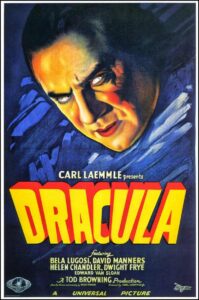Released in 1931, “Dracula” was an early Universal Horror film, and one of the first full-length supernatural horror films. It ended up being a hit with audiences, helping to kick off Universal’s horror streak and defining the character of Dracula for decades to come. That said, the film is far from excellent.
One of the best parts of “Dracula” is the gothic atmosphere. Covered in shadows, fog, and cobwebs, the set of Castle Dracula perfectly encapsulates the gothic horror mood. No other version of “Dracula” has managed to replicate the haunted feel of this film’s set design.
The only thing better than the spooky set design is Bela Lugosi’s famous portrayal of Count Dracula. Lugosi’s performance is so iconic that it defined the character of Dracula in popular culture. The cape with the high collar, the formal wear, the Transylvania accent, and the charming smile are all trademarks established by Lugosi.

While Lugosi is iconic, the other actors are forgettable. Many of the other actors feel stiff and stilted, with the exception of Renfield, played by Dwight Frye, and Renfield’s attendant Martin, played by Charles K. Gerrard. In contrast to the stiff performances, Renfield is melodramatic and over-the-top, yet still manages to be effectively creepy at times. Martin’s comedic presence, however, is completely out of place and feels tonally jarring.
The runtime is only 85 minutes long, yet it is not a fast-moving film. Many scenes feature people talking and speaking very slowly, which really messes with the film’s sense of tension. This slow pacing is accentuated by the stiff performances and the film’s direction, which presents the film like a stage play by mainly using standard wide and medium shots.
Despite the slowness of the pacing, it moves quickly in terms of narrative, staying faithful to Bram Stoker’s iconic novel. Having just read the book, I was able to fill in the many blanks, but the average viewer may feel a bit lost, as the film leaves many things unexplained.
In 1998, composer Philip Glass was commissioned to create an updated score for “Dracula,” which was played by the Kronos Quartet. While at times this score can be a bit overbearing, it is ultimately a powerful addition to the film. Glass’s music captures the essence of “Dracula” and I believe this to be the definitive version of the film.
Despite the flaws of the film, Lugosi’s Dracula will forever hold a notable spot in horror culture.